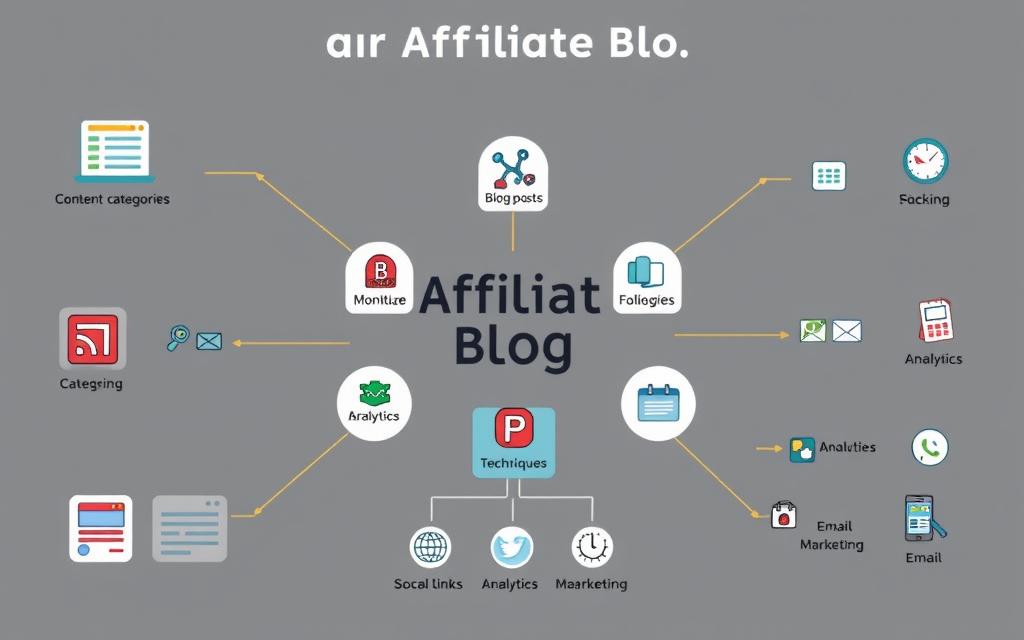Social media is now a key tool for businesses to reach their audience, grow their brand, and increase sales. It doesn’t matter if you’re a small startup or a big company. Learning how to use social media well can open up many opportunities. But, where do you begin? How do you find your way through the changing world of social media and make a strategy that speaks to your customers?
Get ready for a detailed journey into the world of social media marketing. This guide will cover the basics, why a good strategy is crucial, and how to make content that grabs your audience’s attention. You’ll learn how social media can help your business soar.
Key Takeaways
- Discover the key components of social media marketing and how to leverage them for your business.
- Learn the importance of social media marketing in building brand awareness and driving growth.
- Explore the most popular social media platforms and how to choose the right ones for your target audience.
- Craft an effective social media strategy that aligns with your business goals and resonates with your customers.
- Uncover the secrets to creating engaging content that captures the attention of your followers.
What is Social Media Marketing?
Social media marketing is a powerful tool for businesses. It helps them connect with their audience, build brand awareness, and increase engagement. It involves using online platforms to share content that customers find interesting.
Definition and Overview
Social media marketing uses platforms like Facebook, Twitter, and Instagram to promote products or services. It includes creating content, running ads, and keeping an eye on what people say about your business online.
Key Components of Social Media Marketing
- Content Strategy: A good content strategy is key. It means creating content that is valuable, informative, and fun. This content should match your brand’s message and appeal to your audience.
- User Engagement: Social media is about building relationships and community. It’s important to interact with your followers, answer their comments, and encourage them to share their own content.
- Platform Selection: Picking the right social media platforms is crucial. Each platform reaches different people and has its own features. Choose platforms that fit your business goals and audience.
- Analytics and Optimization: Keeping an eye on your social media performance is vital. Analyze important metrics and adjust your strategy based on the data to succeed in the long run.
By understanding and using these key components, businesses can make the most of social media. They can reach more people, increase their visibility, and grow their business.
The Importance of Social Media Marketing
Social media is key for businesses today. It helps with brand awareness and online presence. Companies use Facebook, Instagram, and Twitter to connect with people, build relationships, and achieve goals.
Benefits for Businesses
Social media marketing has many benefits. It’s a cheap way to reach more people. Companies can show off what they offer and who they are. They can get leads, more website visits, and sales.
It also lets businesses talk to customers in real time. This builds loyalty and improves service.
Impact on Brand Awareness
Social media boosts brand awareness a lot. Sharing good content makes a company look like a leader. This builds trust and makes people more likely to buy from them.
Nike is a great example. Its campaigns and content have made it a well-known brand. Nike uses social media to connect with people, which helps with loyalty and sales.

“Social media is not just a spoke in the wheel of marketing. It’s becoming the way entire bicycles are built.”
– Ryan Lilly, Vice President of Media at Fueled
Social media marketing is very important. It helps businesses grow online, connect with people, and succeed.
Choosing the Right Social Media Platforms
In the fast-changing world of social media, picking the right platforms for your business is key. It helps boost user engagement and keeps you updated with social media trends. Knowing who uses each platform helps you plan your marketing better.
Overview of Major Platforms
The social media world is huge, with sites like Facebook, Instagram, Twitter, LinkedIn, and TikTok. Each one attracts different people and offers unique features. Learning what each platform does best is the first step to a good social media marketing plan.
Audience Demographics
Understanding your audience’s age, gender, interests, and habits is crucial. For example, younger people love Instagram and TikTok for their visuals. Meanwhile, LinkedIn is great for professionals.
Matching Platforms to Goals
| Platform | Ideal for | Key Features |
|---|---|---|
| Broad audience engagement, community building | Newsfeed, groups, events, targeted ads | |
| Visual storytelling, influencer marketing | Photo/video sharing, Instagram Stories, shoppable posts | |
| Real-time updates, customer service, trend monitoring | Tweets, retweets, hashtags, live tweeting | |
| Professional networking, B2B marketing | Profiles, connections, groups, sponsored content | |
| TikTok | Short-form video content, reaching younger audiences | Vertical video, trending challenges, algorithm-driven discovery |
By matching your social media marketing goals with each platform’s strengths, you can boost user engagement. This leads to better results in your social media efforts.
Creating a Social Media Strategy
Creating a solid social media strategy is key for businesses wanting to grow. It helps boost brand awareness and connect with the right audience. This involves setting clear goals, knowing your ideal customers, and making content that speaks to them.
Setting SMART Goals
A good social media strategy starts with SMART goals. These goals are specific, measurable, achievable, relevant, and have a deadline. They should match your business goals and guide your social media actions. With clear goals, you can track your success and improve your content strategy based on data.
Identifying Target Audience
Knowing your audience is crucial for making content they’ll love. Do deep research to find out who they are, what they like, and what problems they face. This info helps you decide what content to make, where to share it, and how to build brand awareness.
Crafting Engaging Content
After setting your goals and knowing your audience, it’s time to make engaging content. Plan out your posts with a content calendar that includes different types of content. Try out images, videos, and interactive posts to keep your audience interested and involved with your brand.

“The key to effective social media marketing is to create content that your audience finds genuinely useful and interesting, not just promotional.”
By using these strategies, businesses can make the most of social media. They can attract more visitors, get leads, and build strong customer relationships.
Content Creation for Social Media
Social media is always changing, and making good content is key to success. You need to make content that grabs people’s attention and gets them talking. Whether it’s photos, videos, or captions, knowing what your followers like is crucial.
Types of Content to Post
Social media has many ways to share content. You can use images, infographics, videos, and even content from your followers. Mixing up what you post keeps your audience interested and coming back.
Best Practices for Visuals
- Make sure your images are high-quality and fit your brand’s look
- Play with colors, fonts, and layout to make your visuals stand out
- Use videos because they’re engaging and people love to share them
- Share content from your followers to build a community
Writing Captivating Captions
Captions are just as important as the visuals. They should be short, interesting, and speak to your audience. Write in a friendly way, use hashtags, and ask questions to get people talking.
| Content Type | Best Practices | Examples |
|---|---|---|
| Images | Use high-quality, visually appealing imagery that aligns with your brand’s aesthetic | Showcase your products in lifestyle settings, share behind-the-scenes moments, or highlight user-generated content |
| Videos | Experiment with various video formats, such as tutorials, product demos, or short-form content | Showcase your brand’s personality, provide valuable insights, or create entertaining content that captures your audience’s attention |
| Infographics | Design visually engaging infographics that convey complex information in a clear and concise manner | Educate your audience on industry trends, share data-driven insights, or provide step-by-step guides |
“Visuals are a powerful tool for captivating your audience and fostering meaningful connections on social media. By embracing the principles of visual storytelling, you can create content that not only informs but also inspires and delights your followers.”
Social Media Advertising
Social media ads are a big deal in digital marketing. They help businesses get their brand out there and reach the right people. With the huge number of users and smart targeting, ads can really work well and show results.
Overview of Paid Campaigns
There are many types of ads on social media, like images, videos, and even AR experiences. Businesses can plan their ad spending to get the best results. They can match their ads to what each platform is all about.
Targeting Options
- Demographic targeting: Reach users based on factors like age, gender, location, and interests.
- Behavioral targeting: Leverage data on user behaviors, online activities, and purchasing habits to serve highly relevant ads.
- Lookalike targeting: Expand your reach by targeting users who share similar traits with your existing customer base.
- Retargeting: Reengage users who have previously interacted with your brand or website.
Measuring Ad Performance
Good social media ads need to keep getting better. By watching things like impressions, clicks, engagement rates, and conversions, marketers can see what works. Social media analytics tools give them the data they need to improve their ads.
| Metric | Definition | Importance |
|---|---|---|
| Impressions | The number of times an ad is displayed to users | Indicates the reach and visibility of your ad |
| Click-through Rate (CTR) | The ratio of clicks to impressions | Measures the ad’s ability to capture user attention and drive engagement |
| Conversion Rate | The percentage of users who take a desired action, such as making a purchase | Evaluates the ad’s effectiveness in driving tangible business outcomes |
“Effective social media advertising is not just about creating eye-catching ads; it’s about understanding your audience, optimizing your targeting, and continuously measuring and refining your approach to drive meaningful results.”
Engaging with Your Audience
In the world of social media marketing, effective community management is key. It helps you build meaningful connections with your audience. By engaging with your followers, you can create a loyal community around your brand. This boosts user engagement and drives business growth.
Building a Community
To start a thriving online community, first understand your target audience. Listen to their needs, interests, and pain points. Tailor your content and interactions to meet their needs.
Encourage user-generated content, host social media challenges, and join conversations. This creates a sense of belonging and shared experiences.
- Respond to comments and messages promptly and with a personalized touch.
- Acknowledge user milestones, such as brand anniversaries or follower growth.
- Collaborate with your community members to co-create content or host events.
Responding to Comments and Messages
Timely and thoughtful responses to comments and messages are crucial. They help build trust and maintain a positive brand reputation. Develop a clear strategy for addressing inquiries, handling complaints, and fostering ongoing dialogues.
- Prioritize responding to messages that require immediate attention, such as customer service inquiries.
- Craft responses that are empathetic, helpful, and align with your brand’s tone and voice.
- Leverage user feedback to improve your products, services, and overall social media strategy.
By focusing on community management and user engagement, you can turn your social media channels into vibrant spaces. These spaces foster lasting relationships with your audience and drive long-term business success.
“The key to successful community management is to listen, engage, and genuinely care about your audience. When you make your community feel valued, they’ll become your most loyal brand ambassadors.”
Analyzing Social Media Performance
Social media marketing is key to any good content strategy. It’s important to track your performance and analyze data to make smart choices. By watching key metrics and using strong analytics tools, you can learn a lot. This knowledge helps you improve your social media efforts and get better results.
Key Metrics to Track
There are important metrics to watch in social media analytics. These include:
- Engagement rate: Shows how your audience interacts with your content, like likes, comments, and shares.
- Reach and impressions: Tracks who sees your posts, giving insights into your content’s visibility.
- Click-through rate (CTR): Shows how well your content drives traffic to your website or other actions.
- Follower growth: Watches your social media following grow, showing your content and strategy’s success.
Tools for Analytics
To analyze your social media, you can use many tools. These include:
- Native platform analytics: Most platforms have built-in tools for detailed data about your account and content.
- Third-party analytics tools: Tools like Google Analytics, Hootsuite, and Sprout Social offer detailed social media analytics.
- Custom data dashboards: By combining different data sources, you can create detailed dashboards for a full view of your social media performance.
Adjusting Your Strategy Based on Data
With a good grasp of your social media analytics, it’s time to act. Use the insights you’ve gathered to:
- Identify top-performing content and use those successful strategies as a guide.
- Understand your audience better, helping you create more relevant and engaging content.
- Optimize your posting schedule and timing to reach your followers when they’re most active.
- Refine your targeting and advertising to reach the right people with your message.
By always analyzing your social media analytics and making smart changes, you can keep yourcontent strategy effective and aligned with your business goals.
Future Trends in Social Media Marketing
The digital world is always changing, and social media marketers need to keep up. Trends like short-form video, AI in marketing, and adapting to algorithm changes are key. These trends will shape the future of social media marketing.
Rise of Short-Form Video
Platforms like TikTok and Instagram Reels are popular for their short, engaging videos. Brands that use short-form video in their strategies will grab their audience’s attention. This can lead to higher engagement rates.
The Impact of AI on Marketing
Artificial intelligence is changing marketing on social media. AI tools help with tasks like content curation and campaign optimization. This makes marketing more efficient and data-driven. As AI gets better, its role in marketing will grow.
Keeping Up with Algorithm Changes
Social media platforms often update their algorithms, affecting how content is seen. To succeed, marketers must be quick to adapt. They need to make sure their content still connects with their audience and brings results.












Leave a Reply